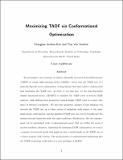Maximizing TADF via Conformational Optimization
Author(s)
Kim, Changhae Andrew; Van Voorhis, Troy
DownloadAccepted version (7.041Mb)
Open Access Policy
Open Access Policy
Creative Commons Attribution-Noncommercial-Share Alike
Terms of use
Metadata
Show full item recordAbstract
We investigate a new strategy to enhance thermally activated delayed fluorescence (TADF) in organic light-emitting diodes (OLEDs). Given that the TADF rate of a molecule depends on its conformation, we hypothesize that there exists a conformation that maximizes the TADF rate. To test this idea, we use time-dependent density functional theory (TDDFT) to simulate the TADF rates of several TADF emitters while varying their geometries in a select subspace of internal coordinates. We find that geometric changes in this subspace can increase the TADF rate up to 3 orders of magnitude with respect to the minimum energy conformation, and the simulated TADF rate can even be brought into the submicrosecond time scales under the right conditions. Furthermore, the TADF rate enhancement can be maintained with a conformational energy that might be within the reach of modern synthetic chemistry. Analyzing the maximum TADF conformation, we extract a number of structural motifs that might provide a useful handle on the TADF rate of a donor-acceptor (DA) system. The incorporation of conformational engineering into the TADF technology could usher in a new paradigm of OLEDs.
Date issued
2021Department
Massachusetts Institute of Technology. Department of ChemistryJournal
Journal of Physical Chemistry A
Publisher
American Chemical Society (ACS)
Citation
Kim, Changhae Andrew and Van Voorhis, Troy. 2021. "Maximizing TADF via Conformational Optimization." Journal of Physical Chemistry A, 125 (35).
Version: Author's final manuscript